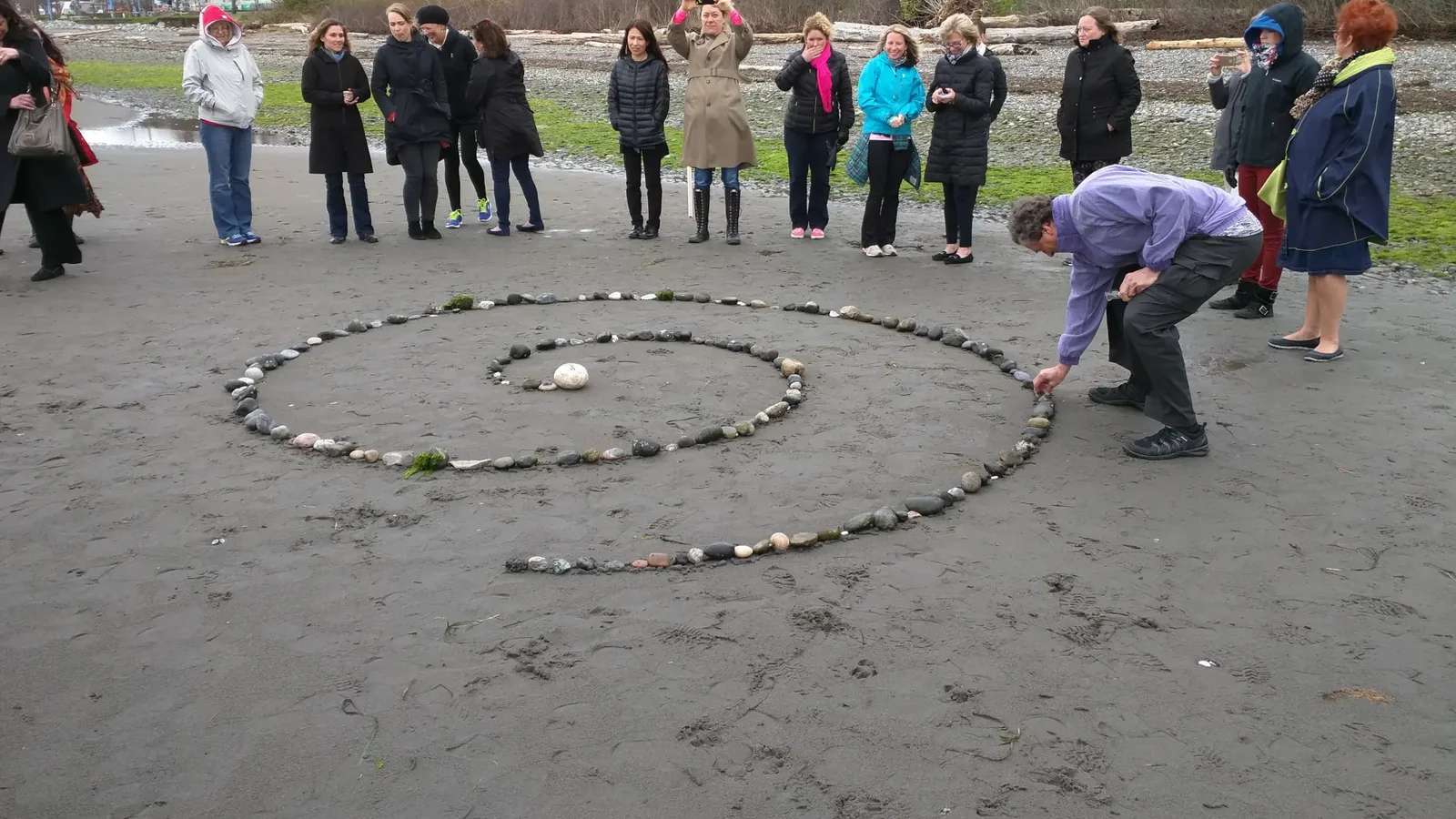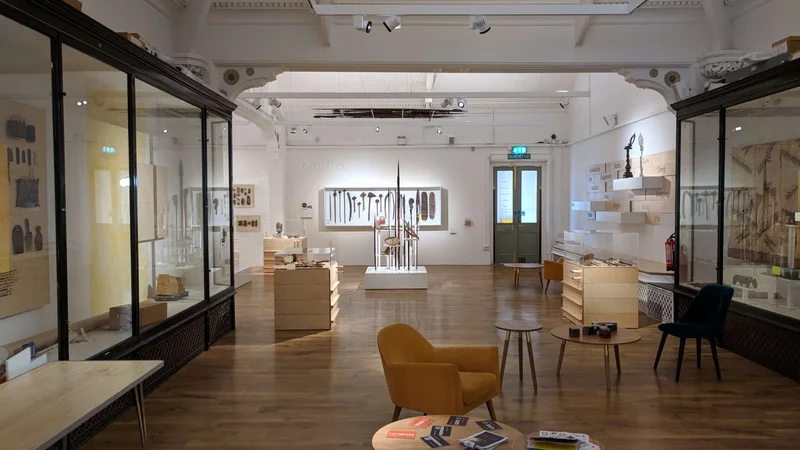Museums are not only sites of exhibition but also gathering places for dialogue, learning, and collaboration. Community partners—including Indigenous nations, refugee organizations, survivors' groups, and human rights advocates—bring lived experiences and knowledge that are essential to a museum's work. Ideally, collaborations are rooted in reciprocity and mutual respect, with museums acting not as the sole authority but as facilitators of shared storytelling.
In practice, collaboration is challenging. Timelines, budgets, and institutional protocols may limit how fully communities can be engaged. Sometimes, communities carry histories of mistrust toward institutions due to colonization, misrepresentation, or broken promises. Trauma-informed practice acknowledges these histories and aspires to create conditions where partnerships feel safe, empowering, and sustainable.
Understanding Safe Space
Safe space is a broad term, well-explored in the psychological literature, describing the extent of emotional safety that people feel in truthfully sharing their emotions and experiences. It is a term commonly used in counselling and psychotherapy but (until recently) less common in the workplace. However, organizations are increasingly recognizing that safe space is foundational to workplace mental health. In situations where emotional content is specifically addressed—as in the case of museums cultivating trauma-informed practices—creating safe space must be a primary goal. Participants need to feel that they can speak honestly and openly about their experiences in dealing with traumatic material, how those experiences have impacted their mental health, and how they view the impacts on colleagues and visitors.
At the same time, no space can ever be completely safe. Human beings are complex and unpredictable in their emotions and reactions, and even the most well-intentioned environments cannot eliminate the possibility of discomfort or harm. To claim a setting is safe may unintentionally suggest that all feelings, experiences, and expressions can be fully contained or anticipated. This is not the case. Emotional safety is a shared and evolving practice rather than a guaranteed condition. It depends on mutual respect, awareness, and accountability.
Safety does not mean the absence of boundaries. In group and community settings, participants must understand that they cannot say whatever they wish, whenever they wish. Emotional safety requires limits: clear norms that guide how people speak, listen, and respond. Unrestricted or unmoderated sharing, especially in situations where emotions are intense and active, can easily lead to harm. One person's unbounded expression can become another person's retraumatization. Establishing and maintaining boundaries of language, tone, and timing helps create the containment that allows difficult experiences to be explored without overwhelming others or re-enacting distress.
Boundaries are not barriers to expression; they are the structures within which trust and openness can emerge. A spiral labyrinth works because it has boundaries—the lines that mark the path—but within those boundaries, infinite variation is possible. The same is true in creating safe space for trauma-informed work. We offer structure and consistency, and within that container, people find their own way.
The Foundation: Multiple Sessions, Not Single Encounters
One of the most important—and most overlooked—principles of trauma-informed community work involves time. Single sessions or open drop-in gatherings, however well-intentioned, do not provide enough context for building belonging, trust, and safety. These are the very conditions required for meaningful engagement with difficult content. Without them, single sessions risk causing harm.
Trauma and vicarious trauma happen commonly in open sessions that lack sufficient structure and relational foundation. When people gather for the first time to discuss residential schools, genocide, displacement, or systemic violence—topics freighted with personal and collective pain—they typically do so without knowing one another, without established norms, without trust. In these conditions, someone may share something deeply vulnerable only to have another participant respond in a way that feels dismissive or harmful. Someone may become overwhelmed with no sense of whether the space can hold them. The facilitator, lacking knowledge of group dynamics and individual histories, may miss crucial signals of distress.
This is not theoretical. It happens regularly in museum and community settings where institutions convene people around difficult topics without adequate preparation or sustained engagement. The resulting harm can be significant: participants leave feeling exposed, unheard, or retraumatized. They may never return. They may tell others that the museum is not safe. And they would be right.
The alternative is to structure community engagement as a series of multiple sessions—ideally at least six—where the same group gathers repeatedly over time. This structure creates the conditions necessary for safe and meaningful work. It allows people to get to know one another. It builds trust incrementally. It establishes norms and rhythms. It provides time to repair ruptures when they occur. And crucially, it allows difficult conversations to emerge naturally once the foundation has been laid, rather than forcing them prematurely.
What Multiple Sessions Offer
A series of six or more sessions creates a developmental arc. Early sessions focus on building relationship and safety. Middle sessions deepen engagement and begin to address challenging content. Later sessions allow for integration, reflection, and planning for what comes next. This arc mirrors the way that meaningful human connection and healing actually unfold—slowly, with care, through repeated encounters.
In the first session, people arrive as strangers. The focus is not on the difficult topic but on beginning to know one another. Introductions happen, but not the formal, stilted kind where people state their credentials. Instead, people might be invited to share something simple and personal: a place that matters to them, an object they carry, a memory of kindness. The group might walk together—outside if weather permits—allowing conversation to emerge naturally in pairs or small clusters. Walking side by side, rather than sitting face to face, eases the intensity of eye contact and creates space for quieter people to participate. Or the group might share a meal together, the act of eating providing both ritual and pause. Food has always been a way humans create community and mark moments of gathering.
In the second and third sessions, the group begins to develop its own culture. People remember one another's names and stories. Inside jokes emerge. Norms become clearer: how long people talk, how silence is held, what happens when disagreement arises. The facilitator continues to prioritize relationship-building but can begin to introduce creative or experiential activities that require collaboration. Making something together—drums, weavings, paper lanterns, garden beds—engages the hands and the body in ways that deepen connection. These activities are not distractions from the real work; they are the real work. They create shared experience and shared meaning. They allow people to contribute in ways that don't require verbal articulateness. They produce tangible objects that carry the memory of being together.
By the fourth and fifth sessions, the group has developed enough trust and safety to begin engaging with difficult content. This is when conversations about residential schools, about cultural appropriation in exhibitions, about representation and voice can happen productively. People know the group well enough to take risks. They know who will listen with empathy and who might struggle. They know the facilitator can hold complexity and will intervene if things become unsafe. Crucially, they have practiced being together during easier moments, so when difficulty arises, they have a foundation to return to. The container is strong enough to hold what emerges.
In the final session or two, the group reflects on the journey. What have we learned together? What remains unresolved? How will this work continue beyond these gatherings? There may be ritual closure: sharing gratitude, offering blessings, lighting candles, or returning to an activity from early sessions to mark how far the group has come. Participants should leave not only with whatever work was accomplished—consultation on an exhibition, development of interpretive text, identification of partnership opportunities—but also with the experience of having been part of something meaningful, something that honored their humanity and their contributions.
Incorporating Creative and Experiential Work
Each session should incorporate some form of creative or experiential engagement, not only discussion. This serves multiple purposes. First, it regulates the nervous system. Talking about trauma can be activating; doing something with the hands helps ground and settle. Second, it creates entry points for those who think and process differently. Not everyone is comfortable with verbal discussion, but almost everyone can participate in making, walking, or tending. Third, it builds relationship through shared activity in ways that talking alone cannot. Working side by side on a garden bed or crafting a drum creates a different quality of connection than sitting across a table.
The specific activities should be chosen thoughtfully, in consultation with community partners when possible, and should connect meaningfully to the work at hand. If the group is consulting on an exhibition about land and displacement, perhaps sessions include walking the land around the museum, gathering stones or plants, creating small earthworks or cairns. If the focus is cultural expression, perhaps the group makes traditional crafts, cooks traditional foods, learns songs or stories. If the work involves healing from historical trauma, perhaps sessions incorporate ceremony, drumming, or time in nature.
These activities need not be elaborate or require extensive resources. Even simple acts—brewing tea together at the start of each session, lighting a candle to mark the opening and closing, walking in silence for ten minutes—create ritual and rhythm. What matters is consistency and intentionality. The activities are not filler; they are integral to the process of building the relational foundation that makes difficult work possible.
Practical Strategies
Commitment from the start. When inviting participants, be clear that this is a series, not a single session or drop-in opportunity. Ask people to commit to attending all sessions if possible. This commitment signals seriousness and helps the group cohere. Some people will be unable to commit to every session due to life circumstances; that's understandable. But the aspiration is for a stable core group that develops continuity.
Consistent facilitation. The same facilitator (or facilitation team) should be present for all sessions. Changing facilitators between sessions disrupts trust and requires starting over with relationship-building. The facilitator becomes a consistent presence, a holder of the group's story, someone who remembers what was said in session two and can reference it in session five.
Clear agreements. In the first session, establish norms together: confidentiality (with clarity about any limits), respect for different perspectives, the right to pass or step out, how conflict will be handled, expectations around attendance. These agreements can be revisited and revised as needed, but having them creates a shared container.
Accessibility support. Ensure translation, transportation assistance, child care, or other supports are available for all sessions, not just some. If someone cannot attend because they lack child care, the series fails for them.
Compensation. Pay participants for their time and expertise, not only for the final product but for their participation in the process. This might be honoraria, gift cards, or other forms of recognition. Time is valuable; expertise is valuable. Compensation demonstrates respect.
Space for ceremony and culture. If participants wish to open or close sessions with cultural practices, welcome this. Allow extra time so these practices don't feel rushed. Work with cultural advisors or Elders to ensure practices are conducted appropriately.
Documentation with care. If sessions are recorded or notes taken, be transparent about this. Participants should know who will have access and how materials will be used. For some content, participants may prefer that certain stories or perspectives remain unrecorded—shared verbally in the moment but not documented. Honor these boundaries.
Follow-up between sessions. Check in with participants between gatherings, especially if someone seems distressed or withdraws. Brief emails or calls—Just wanted to see how you're doing after last session—maintain connection and demonstrate ongoing care.
Safe Group Facilitation
Community gatherings, particularly those structured across multiple sessions, require skilled facilitation. The facilitator's role is complex: hold space without controlling it, invite participation without demanding it, notice patterns without judging, intervene when needed without overstepping. The skills required are those explored throughout this trauma-informed practice guide: self-awareness, presence, empathy, congruence, boundaries.
The facilitator must be aware of their own activation, their own biases, their own discomfort with silence or conflict. They must be able to recognize when the container needs strengthening—when energy is scattered, when someone is overwhelmed, when conflict is emerging. They must know how to intervene in ways that support rather than control: It seems like we're moving in several directions at once. Should we pause and see where we actually want to focus? or I'm noticing this conversation is landing heavily. Let's take a breath together.
Facilitators should ideally receive training in trauma-informed group processes. This is not work that can be done well simply by reading a manual. It requires practice, supervision, feedback, and ongoing learning. Museums developing this capacity should invest in training facilitators thoroughly and provide them with ongoing support through consultation and peer supervision.
Preparing Participants in Advance
Even with multiple sessions, preparation remains crucial. Before the first gathering, community partners should know: What is the purpose of these sessions? What will we be working toward together? How many sessions are planned? What kinds of activities might be involved? How will contributions be used? What happens after the series concludes?
This information should be provided in accessible formats—written materials for those who want them, phone calls for those who prefer verbal explanation, meetings with community leaders who can communicate with their members. The goal is informed consent: people should choose to participate knowing what they're agreeing to.
Preparation also includes being honest about constraints. If the museum cannot guarantee that community input will determine final decisions, say so. If budget limits certain possibilities, acknowledge this. If timelines are fixed due to external factors, explain why. Honesty about limits builds trust more effectively than overpromising and underdelivering.
The Value of Follow-Up
When a series of sessions concludes, follow-up becomes even more important. Participants have invested significant time and emotional energy. They deserve to know what happened with their contributions. Did their input shape the exhibition? Were their concerns addressed? If recommendations couldn't be implemented, why not?
Follow-up might include a report summarizing the series and its outcomes, individual thank-you notes to participants, an invitation to a preview of the exhibition or project they contributed to, ongoing consultation as implementation progresses, or a final gathering several months later to reflect on impact.
Follow-up also creates an opportunity to address any harm that occurred during the series. Despite best intentions, things can go wrong. Someone might have felt unheard. A conflict might have left residue. The facilitator or museum representative can reach out: I've been thinking about what happened in session four. I wanted to check in with you about it. These conversations, difficult as they are, demonstrate accountability and commitment to relationships.
Shared Authority and Power Dynamics
The multiple-session structure creates conditions for more genuine shared authority. When people gather only once, power imbalances persist: the museum sets the agenda, controls the timeline, and extracts what it needs. But across six sessions, different dynamics can emerge. Participants can suggest topics for discussion. They can propose activities. They can challenge assumptions and push back on framings. The group develops its own culture, one that the museum doesn't fully control.
This can be uncomfortable for institutions accustomed to being in charge. But it is necessary for trauma-informed practice. True collaboration requires ceding some control, trusting the group's process, and allowing outcomes to emerge rather than being predetermined. The facilitator's role shifts from leading to accompanying, from directing to holding space for whatever the group needs to work through together.
Transparency about power remains important. The museum retains certain authorities—budget decisions, final exhibition choices, timelines. These should be named honestly. But within those constraints, much can be negotiated and shared. Perhaps participants can help decide how honoraria are distributed. Perhaps they can suggest which sessions include ceremony. Perhaps they influence not only content but also process: how meetings run, what activities are chosen, how decisions are made.
Toward Sustainable Partnerships
Trauma-informed collaboration is an ongoing process requiring preparation, sustained engagement across multiple sessions, creative and experiential work alongside discussion, and thoughtful follow-up. Constraints are real—budgets, timelines, institutional requirements—but structuring engagement as a series rather than single encounters fundamentally shifts what becomes possible.
The aspiration is for museums to be seen not only as institutions that tell stories about communities but also as places that enact values of respect and reciprocity in their relationships. And relationships require time—time to build trust, time to repair when things go wrong, time to develop the safety needed to engage with difficult content. They cannot be rushed or compressed into single encounters without causing harm.
By fostering dialogue across multiple sessions, incorporating creative and experiential work, preparing thoughtfully, facilitating with skill and humility, compensating fairly, and following up with care, museums can ensure partnerships are genuine, dignified, and sustainable. Museums become places where communities actively shape the narratives that affect them. And perhaps most importantly, they become places where the process itself—the walking together, the making together, the sitting with difficulty together—honors the humanity of everyone involved.
To light a candle is to cast a shadow.
Next
Guide Navigation
The introductory page of the guide provides the context and rationale for trauma-informed museum practices and includes an overview of each page.
Understanding Trauma in Museum Contexts explores how trauma operates as a complex, ecological phenomenon affecting visitors, staff, and community partners. It examines the neuroscience of trauma responses, the patterns that emerge from person-environment interactions, and why museums need this foundational knowledge.
Considerations for Trauma-Informed Training addresses the personal dimension of this work—why trauma-informed training must be fundamentally different from typical professional development, how to build skills safely, and the importance of self-awareness and empathy as foundations for supporting others.
Core Principles of Trauma-Informed Practice outlines five interconnected principles—safety, trust, belonging, empowerment, and empathy—that guide all trauma-informed work. These are not implemented once but practiced continually, shaping how exhibitions are designed, how staff interact, and how partnerships are formed.
Supporting Colleagues examines what it means to care for one another in workplaces where exposure to traumatic content is routine. It explores the skills of presence, the importance of boundaries, and how to create a culture where supporting each other becomes ordinary rather than exceptional.
Trauma-Informed Exhibition Planning addresses the challenge of creating exhibitions that convey difficult truths with honesty while respecting visitor wellbeing. It offers practical strategies for content advisories, visitor choice, regulation spaces, and creative engagement that honors both truth-telling and care.
Working with Community Partners explores how to build genuine, reciprocal partnerships with communities whose traumatic histories museums represent. It emphasizes the importance of multiple sessions over time, incorporating creative work alongside discussion, and creating conditions where trust can develop.
Sustaining the Practice addresses how trauma-informed approaches become embedded in organizational culture rather than remaining isolated initiatives. It explores onboarding, documentation, leadership modeling, policy alignment, and the long-term work of creating environments where care is expected and practiced.



